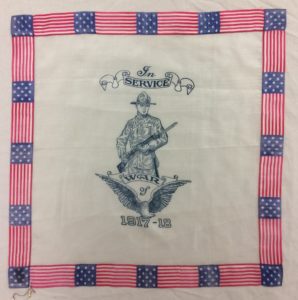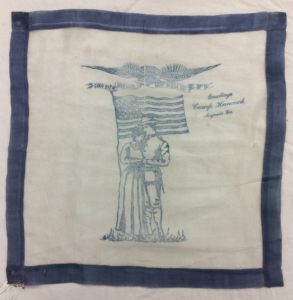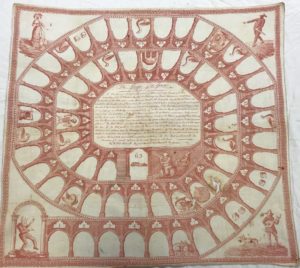 More than just a simple cloth square to catch a sneeze, the humble handkerchief can offer us a glimpse into a historical period in time. Colorado State University’s Avenir Museum of Design and Merchandising will display a variety of handkerchiefs from World War I in celebration of the 100-year anniversary of Armistice Day.
More than just a simple cloth square to catch a sneeze, the humble handkerchief can offer us a glimpse into a historical period in time. Colorado State University’s Avenir Museum of Design and Merchandising will display a variety of handkerchiefs from World War I in celebration of the 100-year anniversary of Armistice Day.
A large collection of textiles was donated to the Avenir Museum over the past few years by Robert Coffland in honor of his late wife, Mary Hunt Kahlenberg. The most recent donations arrived over the summer and predominantly feature handkerchiefs.
Rare handkerchiefs
 Nov. 11 will commemorate 100 years since Armistice Day, which marked the end of World War I. Armistice Day became a legal holiday in the U.S. in 1938 and was renamed Veterans Day in 1954. A number of the handkerchiefs are rare examples from both American and European origins, and all were produced during and related to World War I.
Nov. 11 will commemorate 100 years since Armistice Day, which marked the end of World War I. Armistice Day became a legal holiday in the U.S. in 1938 and was renamed Veterans Day in 1954. A number of the handkerchiefs are rare examples from both American and European origins, and all were produced during and related to World War I.
Some of the handkerchiefs in the exhibit are sweetheart souvenirs, while others are commemorative of specific ships, and many more depict the battlefields of France or military training camps in the U.S. As a salute to the end of WWI in 1918, the Avenir Museum is installing a selection of Kahlenberg’s World War I handkerchiefs in the New Threads exhibit, just for the month of November.
There are more than 430 unique items in the collection, and Courtney Morgan, a graduate teaching assistant in the Department of Design and Merchandising, has been hard at work preparing the exhibit that will be on display in the Avenir Museum.
One handkerchief that Morgan researched shares its design with a couple other handkerchiefs in the collection, but is set apart by the letter that came with it, signed “The Old Miller.” Included on the letter was the name of a ship, and Morgan contacted the National Archives to find a muster roll, from which she was able to determine a name. After using Ancestry.com and a second military records database, Morgan was able to identify the letter’s author as Glen O. Miller, a 20-year-old sailor from Ohio.

“Knowing more of the story behind this hankie, including where it came from and who sent it, was incredibly fascinating. It took a bit of sleuthing and creative searching to get the information, and I’m quite impressed we were able to find ‘the Old Miller,’” said Morgan.
The World War I exhibit, which Morgan has been working on with Department of History graduate student Kimberly Selinske, focuses on these textiles and their role in the memory of war.
A unique collection

Beyond the handkerchiefs from the World War I era, the Coffland-Kahlenberg collection contains everything from political hankies from the late 1800s to one advertising California Raisins. Another from the mid-20th century in France has instructions on “how to keep your husband happy.”
One handkerchief is designed like a game board with the rules of “Game of the Goose” in the middle. Morgan found a hankie with the same design in the online museum collection records for Colonial Williamsburg. The Colonial Williamsburg example, in a different set of colors, is dated between 1780 and 1790.
In memory of Kahlenberg
Kahlenberg was a well-known textile scholar, with many published works examining the history and significance of various textile collections. Her expertise developed throughout her life, and she amassed a personal collection with pieces she found on her travels, at antique shops, in textile swap meets, and at flea markets. While the Avenir Museum does not have specific information about where every handkerchief was found, each one is a unique window into history.
Kahlenberg passed away in October 2011. To read the New York Times’ article on her life and career, visit her obituary
The Avenir Museum is in the Department of Design and Merchandising, part of CSU’s College of Health and Human Sciences.